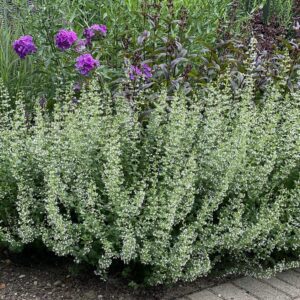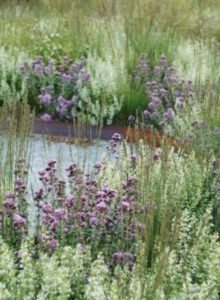To ask a plantsman what their favorite plant is could be compared to asking a toddler what their favorite toy is. When faced with so many options, it can be difficult to narrow down our attention to one spectacular plant. As horticulturists, designers, and gardeners we must consider the multi-faceted nature of plants in the landscape. What purpose is it serving? How will it look in the future? How much maintenance does it require? All of these questions are often taken into account when we are asked “What’s your favorite plant?” and often, it may change from day to day or depending on the project and design.
 We asked Nathan Wright, Founding Partner of Nathan Wright Landscape Design, what his favorite plant is and he confidently answered with Calamintha nepeta ssp. nepeta. Commonly known as Lesser Calamint, this perennial offers some of the most desirable attributes that designers and home gardeners alike look for when considering plants for beautiful and functional gardens. This perennial is reliably hardy in the Chicagoland region (USDA Zone 5) and to USDA Zone 7 (which is considerably warmer).
We asked Nathan Wright, Founding Partner of Nathan Wright Landscape Design, what his favorite plant is and he confidently answered with Calamintha nepeta ssp. nepeta. Commonly known as Lesser Calamint, this perennial offers some of the most desirable attributes that designers and home gardeners alike look for when considering plants for beautiful and functional gardens. This perennial is reliably hardy in the Chicagoland region (USDA Zone 5) and to USDA Zone 7 (which is considerably warmer).
Lesser Calamint features airy, vertical flowering stems clustered with small white blooms. When we asked Nathan what he likes so much about the ornamental aspects of this plant he mentioned the long bloom period (June to October) of the small, teacup shaped flowers and that they shift from white to shades of pale lavender following frost in the fall. The foliage and flowers of the plant also have an incredibly strong fragrance. The pungent, minty aroma can be detected even from a distance, often carried by a warm breeze during summer days and evenings.
Perhaps one of the most notable characteristics of this plant is not the sight or smell of its flowers and foliage, but the sound it creates during the height of the growing season. The flowers attract hundreds of insects during all times of the day, reaching a pinnacle in the afternoon with the summer heat. The sound of the bees, flies, and wasps that all flock to these plants create such a buzz that it feels as though all the air within a few feet is vibrating and humming with nature’s voice. Truly a multi-sensory experience; sitting next to these plants invokes our sense of sight, smell, hearing, and touch. Even covered in bees, there’s no need to be afraid of grabbing a few leaves to get a waft of the pleasant aroma. Nathan says that when his son was only 3, he swung a plastic bat at the plants attempting to get rid of the insects and didn’t suffer a single stinger! The bees and other pollinators are so intent on the flowers and their resources that they have no interest in stinging passersby or those enjoying the sights and scent of the plant.
 Lesser Calamint thrives in full sun but can take partial sun/partial shade. This plant does not like to be kept wet, and will perform poorly if overwatered. Once established, it tolerates periods of drought and dry soil, but it will perform just as well in an evenly moist, well drained soil. It will typically grow to between 12-18” in height and can reach up to 30” in width. Multiple Calamint plants can be grouped together with a spacing of around 12-16” on center to fill a space quickly without harming the plants. The only necessary seasonal maintenance on these plants is a simple cleanup in Spring. Just cut back the previous year’s flowering stems back to about 1” and let the plant do the rest! Although this plant is beautiful and low maintenance on its own, it truly shines when combined with the proper companions.
Lesser Calamint thrives in full sun but can take partial sun/partial shade. This plant does not like to be kept wet, and will perform poorly if overwatered. Once established, it tolerates periods of drought and dry soil, but it will perform just as well in an evenly moist, well drained soil. It will typically grow to between 12-18” in height and can reach up to 30” in width. Multiple Calamint plants can be grouped together with a spacing of around 12-16” on center to fill a space quickly without harming the plants. The only necessary seasonal maintenance on these plants is a simple cleanup in Spring. Just cut back the previous year’s flowering stems back to about 1” and let the plant do the rest! Although this plant is beautiful and low maintenance on its own, it truly shines when combined with the proper companions.
Nathan loves pairing Lesser Calamint with the strongly vertical foliage of Molinia caerulea (Purple Moor Grass), the complimentary purple blooms of Origanum herrenhausen (Ornamental Oregano), and the large, eye catching blooms of Echinacea ‘Pixie Meadowbrite’ (Purple Coneflower). With a combination planting like this, home gardeners can create a beautiful vignette with multi-season interest in any sunny spot in their yard. Pairing this plant with fall-blooming asters and Kniphofia Pyromania ® ‘Backdraft’ provides a perfect combination for dry spots as well!
Calamintha nepeta ssp. nepeta is the perfect example of a plant that embodies the multi-functional appeal of material in modern landscape design. The beauty of a plant is often the most important attribute to many home gardeners, or at least the first thing they may notice. Using plants that check this box but also provide materials for pollinators, use less water, and require less time and inputs for maintenance help us share the responsibility of effectively stewarding our planet’s resources. Nathan Wright Landscape Design is proud to use plants such as Lesser Calamint, and to share its beauty and function with all of our clientele and the world.